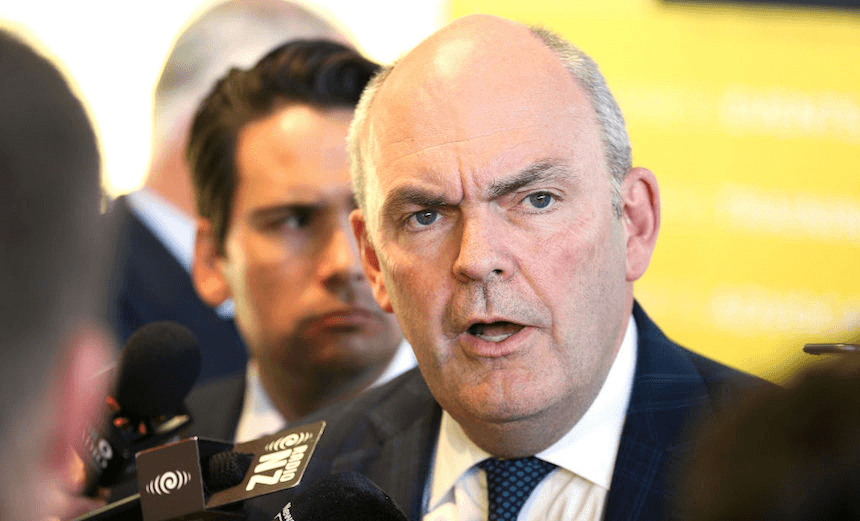The minister of finance just announced a multi-billion dollar spend up – and Auckland should be very worried. Simon Wilson explains how the government’s traffic plans are badly stuck.
Congestion for motorists on Onewa Rd isn’t any better than it ever was, Cr Richard Hills told his colleagues on the Auckland Council today. Despite all the work they’ve done to make Onewa Rd a more efficient arterial route for commuters, the cars are still stuck.
He wasn’t fussed, though, and here’s why. These days only 30 percent of the commuters spilling onto the motorway in the morning from Northcote and Birkenhead are motorists. The remaining 70 percent ride in buses, especially double decker buses, on Onewa Rd’s dedicated bus lane. The cars are struck but the buses go much faster.
You can measure the congestion on Onewa Rd in two ways. The old way is to say the road is still blocked so whatever we’re doing isn’t working. The new way is to say that congestion is being efficiently tackled, not just in the best way, but in the only way possible: by making public transport fast, frequent and functionally efficient for its users.
It takes only a moment to see the flaw in the first response. Yes, motorists are still stuck in traffic. But if those double decker frequent flyers weren’t in action, the functionality of the road probably would have collapsed altogether.
There’s a law of traffic that explains this: traffic expands to fit the available road space. It’s called the Lewis-Mogridge Position, named after the people who discovered it, way back in 1990. It means you can’t fix traffic congestion by building more lanes for private motorists.
True, when you’re stuck in traffic it feels wrong. It feels like there should be more roads. But that’s not the case. More roads encourage more driving, and people keep driving until they can’t. There are two reasons public transport is so important. One is because it can move lots of people. The other, arguably the more fundamental, is that it takes vehicles off the roads and therefore allows those that remain to keep moving.
That is why investment in public transport is not just a component of any smart transport policy, but should be its foundation. And by public transport, I mean fast, frequent and easy to use public transport: trams (“light rail”), electric trains (“heavy rail|) and buses on dedicated lanes and busways.
Read more:
Planes, trains and automobiles: inside the playground fight over the way to Auckland airport
So. Auckland transport is near collapse and nowhere is that more obvious than for people trying to get to or from the airport. What’s the solution? It’s those trams, or trains, or, possibly in the short term, fast buses. And why aren’t we building the lines to make this happen now?
Because the government won’t approve it or fund it. While the Auckland Council was meeting today, 700km away in the capital finance minister Steven Joyce made a speech to the Wellington Chamber of Commerce. He announced an $11 billion additional commitment to infrastructure. He mentioned rail only in passing, except in relation to Kaikōura. He mentioned Auckland only in passing too, saying how much he had enjoyed, the day before, driving on the widened roadways of the northwest motorway and airport route. He was lucky.
Aucklanders are not. Although he didn’t say it, some of Joyce’s new billions will flow to Auckland – but it’s not likely to be in a good way. Political analyst and former mayoral staffer James Bews-Hair, now with the consultancy McGredy Winder, says: “We think … we are seeing the government in the early stages of rolling out a carrot and stick political strategy in relation to Auckland. With the carrot being for ratepayers and the stick for the council. Any investment support coming Auckland’s way will almost inevitably be tied to some prerequisites in terms of the council stepping up to the mark. Equally inevitably, some of these conditions will be things that [mayor] Goff will find it very difficult to stomach politically.”
The government’s refusal to prioritise fast, efficient public transport fails every credible test of good strategic planning. But it doesn’t fail another test: it’s quite possibly a vote winner. The government knows that people stuck in traffic don’t want to sit on a train, they want a free-flowing road. The government knows that in a built-up city at peak times that will never happen. But it’s not going to admit it.
The government sees votes to win among Aucklanders who want to stay in their cars, especially those who don’t like the mayor or the council anyway. And it sees far more votes to win among everyone else in New Zealand who think we’re greedy Jafas who already get far too much attention.
The future of rail to the airport – on trams or trains – is the benchmark measure for how true all this is. This year transport minister Simon Bridges revealed a decision would be 30 years away. Translation: we don’t care.
Meanwhile, the council and transport agencies are moving towards a consensus decision on rail to the airport. Whether to favour trams or trains or even “advanced buses”, and why. What’s at stake? What are the arguments for each and what would they cost? How would it work, where would it go and why aren’t we doing it already?
Clue: the answer is trams. Supertrams! The future of the super-city.
Actually it’s far more complicated than that. But in an effort to make it all a bit more easy to understand, today I wrote an explainer of the trams vs trains debate here.
The Spinoff Auckland is sponsored by Heart of the City, the business association dedicated to the growth of downtown Auckland as a vibrant centre for entertainment, retail, hospitality and business.

